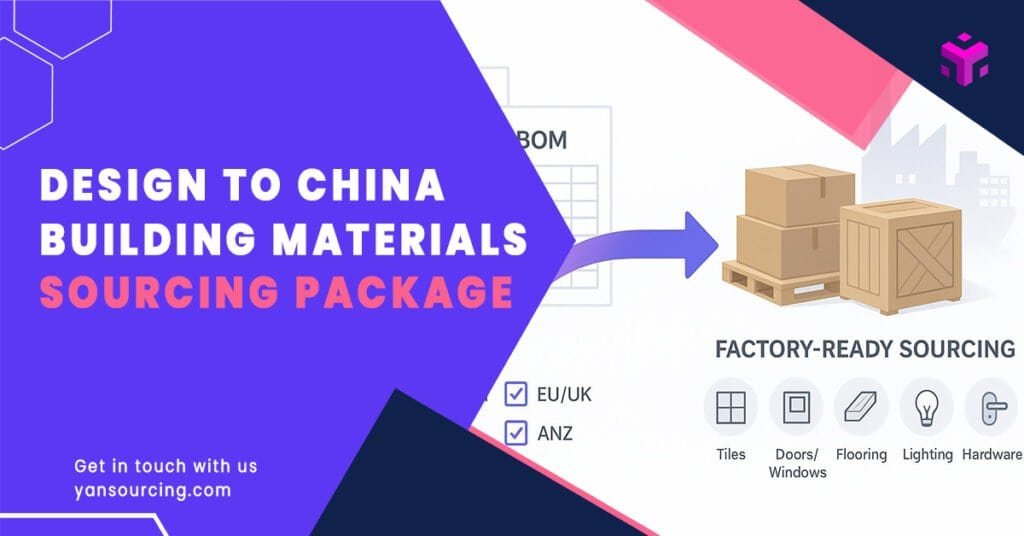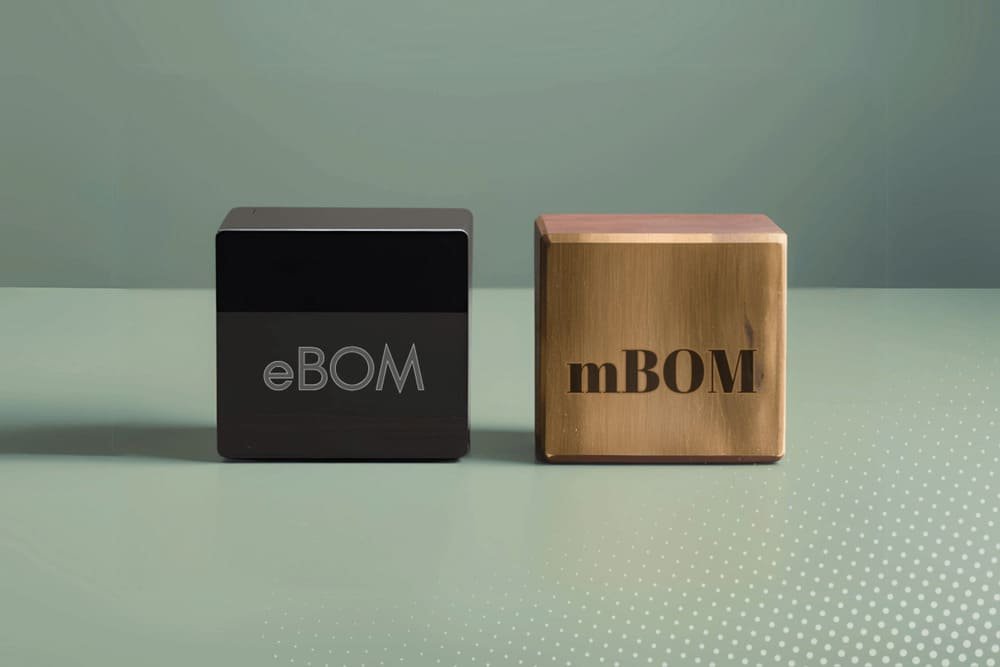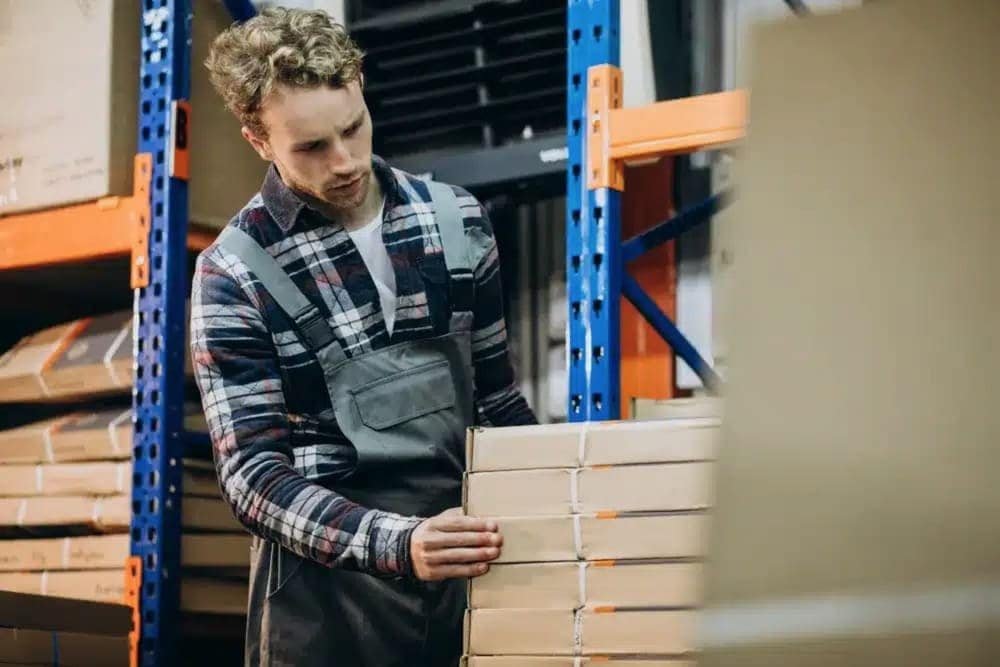
Turning drawings into deliverables that factories can actually quote and build against is where many projects stall. Schedules slip, quotes aren’t comparable, and samples miss the mark.
This guide gives real estate developers, general contractors, and procurement managers a clear, repeatable workflow to convert an architectural design package into a factory-ready China sourcing package—built for multi-region compliance and predictable execution.
1) Lock your markets and build a compliance matrix (before RFQs)

Factories can’t price or sample accurately without knowing which markets your materials must satisfy. Start with a compact, product-family compliance matrix and assign an owner to maintain it.
Include the destination market, applicable standard(s), key test(s), conformity mark(s), labeling, required documents, and any surveillance/renewal notes.
The European Commission explains the Declaration of Performance and CE marking under the Construction Products Regulation in its official overview, Declaration of Performance and CE marking, while the legal text is in Regulation (EU) 2024/3110 on EUR-Lex.
In Great Britain, verify the current recognition of CE and use of UKCA on the GOV.UK page Construction Products Regulation in Great Britain.
For North American emissions on composite wood and finishes, align with the EPA’s Formaldehyde Emission Standards for Composite Wood Products (TSCA Title VI).
Saudi Arabia uses SABER for conformity; see SASO’s Certificates of Conformity overview.
Australia/New Zealand requirements are set by AS/NZS standards; current editions are listed at Standards Australia.
Why this sequence? It prevents rework. Your RFQ language, test plan, and labeling requirements all flow from the matrix. No compliance map, no comparable quotes.
2) Convert EBOM to MBOM (don’t forget consumables and packaging)

The engineering BOM (what the design shows) isn’t yet a manufacturing BOM (what a factory needs to make, test, and ship). Expand each line so suppliers can cost and control quality.
Specify unit of measure and yield/loss assumptions (for example, “Cut-to-size porcelain slabs: 1.8% scrap included; quote per m² net finished area”).
Call out materials and finishes (“Engineered oak plank: E1 core; UV-cured acrylic top coat; color ‘Sand 04’; gloss 20±3 GU; wire-brushed”).
Include dimensional tolerances and flatness/straightness (“Door leaf 915×2134×45 mm; thickness ±0.5 mm; bow ≤3 mm over height”).
Tie performance attributes to the compliance matrix (such as fire, acoustic, slip resistance).
Add per-line compliance identifiers (“TSCA Title VI compliant plywood core; TPC certificate on file; label format attached”).
Treat packaging as its own sub-BOM covering inner wrap, edge protection, carton spec, pallet type/dimensions, desiccant, straps, stretch film, and label content.
Think of this step as giving factories a clear recipe, not just a shopping list.
3) Assemble a factory-ready RFQ pack

Your RFQ pack lets multiple suppliers quote against the same scope and acceptance criteria. Include at minimum:
- MBOM workbook with version control
- Dimensioned drawings and callouts
- Specification sheets with tolerances and acceptance criteria
- Compliance matrix (Section 1)
- Sampling and test plan (which tests, which labs, timing)
- Packaging specification (including palletization and labeling)
- Timeline with gates (sample approval, FAI, pilot run)
- Change control and submittals (drawings, DoP/DoC, labels, artworks)
- Bilingual labeling/artwork if helpful for factory execution
Clarify the expected conformity route upfront: for EU/UK, cite the harmonized standard and whether a DoP and CE marking are required, and in GB specify whether CE or UKCA will be used per the current GOV.UK guidance on CPR.
In North America, call out TSCA Title VI/CARB where relevant and require current certificates and label formats; in Saudi shipments, assign SABER ownership to the importer and request the supporting test reports/certificates from suppliers.
4) Samples, golden/boundary standards, and FAI with AQL

Sampling is your insurance policy against drift between design intent and mass production. Start with pre-production samples to validate materials, finishes, and key dimensions, using a measurement sheet for traceability.
Establish “golden” samples and define “boundary” samples that mark acceptable extremes for color/finish, supported by consistent photo standards or even ΔE thresholds if you use colorimetry.
At the start of mass production, conduct a First Article Inspection (FAI) against drawings, the MBOM, and acceptance criteria, then switch to routine acceptance sampling by attributes using AQL levels defined under ISO 2859-1.
Define what “pass” means before any unit is built to avoid disputes.
5) Engineer packaging to survive distribution; validate with ISTA

Building materials are heavy and unforgiving, so design packaging like it’s part of the product. Specify unit protection (corner/edge guards, foam density), carton board grade and compression targets with a safe maximum weight, pallet type and dimensions with load height/weight limits, wrap pattern and strap count/type, plus moisture barriers and desiccant where needed.
Align labels across inner, master, and pallet levels so SKUs, lots, compliance marks, and handling icons are consistent.
When you’re shipping palletized loads, validate with an appropriate ISTA procedure—many teams use ISTA Procedure 3E for shock, compression, and random vibration—and record parameters, pass/fail criteria, and corrective actions.
6) Documentation, labeling, and traceability across markets

Set the paperwork up once and reuse it across suppliers. In the EU/UK, maintain a technical file aligned to the harmonized EN in scope; issue a DoP and affix CE marking when required, following the European Commission’s Declaration of Performance and CE marking guidance.
In North America, keep TSCA Title VI/CARB certificates and approved label formats; align finished-goods and outer-carton labels.
For Saudi Arabia, track SABER entries, PCoC validity, and an SCoC per shipment.
For Australia/New Zealand, retain accredited test reports and any required standards marks.
Strengthen traceability with batch/lot coding, supplier code prefixes, QR labels that point to spec/DoP pages, and a change log tied to sample photos and reports.
7) Practical example: what a factory-ready RFQ pack looks like

Scenario: A mixed-scope order for porcelain tiles and prehung interior doorsets destined for EU/UK and North America.
Included documents: an MBOM workbook with separate tabs for Tiles and Doorsets; drawings for tile patterns and trim details plus door leaf/frames and hardware prep; spec sheets with color/finish codes, tolerances, and slip/fire notes; a compliance matrix; a sampling/test plan covering tile water absorption and abrasion, door leaf thickness and flatness, finish gloss, and packaging tests; and a packaging spec covering carton ECT, corner protection, pallet pattern, and label artwork.
Compliance matrix slice
| Product | Market | Standard(s) | Key tests/metrics | Mark/Docs |
|---|---|---|---|---|
| Porcelain tiles | EU/UK | EN 14411:2016 | Water absorption ≤0.5%; PEI abrasion per class | CE marking; DoP |
| Porcelain tiles | NA | ANSI A137.1; ASTM C373/C1027 | Water absorption; abrasion (glazed) | Spec + test reports |
| Interior doorset (non-fire) | EU/UK | EN 14351-1 | Air/water/wind (per assembly class) | CE marking; DoP |
| Interior doorset | NA | ASTM E283/E331/E330; NAFS | Air leakage/water/structural; NAFS class | Labels + test reports |
Acceptance criteria snippets: Tiles—Color code “G-12”; tone range T2; caliber Cal 2; water absorption ≤0.5%; visible defects AQL 1.5. Doorsets—Leaf 2040×826×45 mm ±0.5 mm; bow ≤3 mm; hardware prep BHMA A156.x per schedule; finish gloss 20±3 GU.
Disclosure: Yansourcing is our product. A factory-ready RFQ pack like the one above can be reviewed to confirm the compliance matrix, tighten tolerances, and align sampling/FAI and packaging specs so multiple Chinese suppliers quote apples-to-apples and produce consistent samples.
Next steps
- Download the free “China Sourcing Package” checklist/template to turn your drawings into a factory-ready pack. Use it to build your compliance matrix, MBOM, RFQ documents, and test plan.
- Optional: If you want Yansourcing to review your design package and convert it into a factory-ready sourcing pack, our team can assist with materials selection, BOM optimization, and supplier matching.
